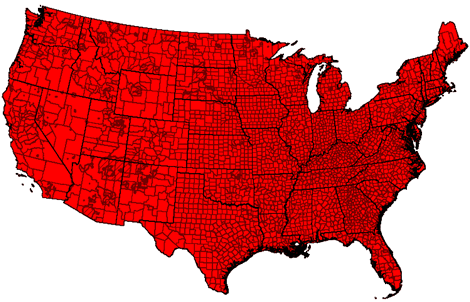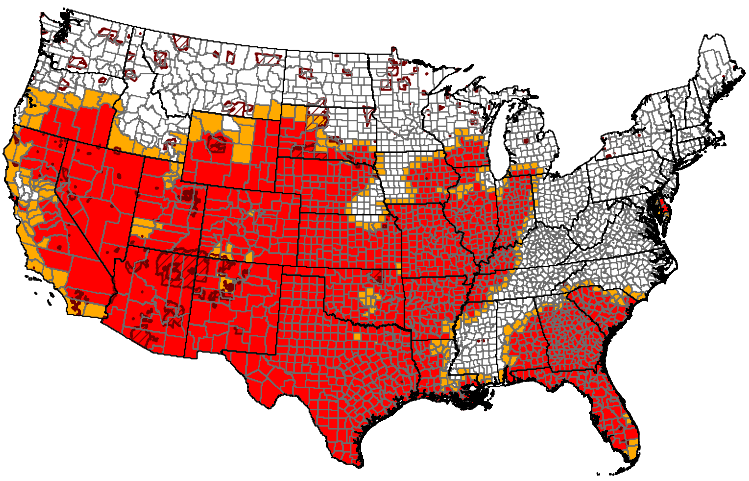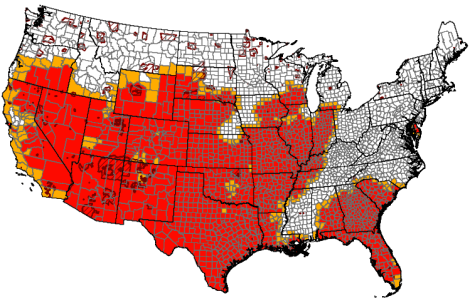Let’s check in on our old friend the drought, shall we? Here’s the key takeaway, if you’re in a big rush:
It still exists.
Today, Agriculture Secretary Tom Vilsack added another 218 counties to the list of drought-afflicted disaster areas, meaning we’ve officially passed the halfway mark. Fully one out of every two American counties has been so designated. Here’s the current map.
Just to save some effort, here’s our projection of that map a month from now.

(I made this one.)
To be fair, that’s not exactly a scientific assessment, but it will either be proven correct or the situation will be better than this. We did it that way because we like to aim high.
It’s climate change’s fault.
Surprising zero rational people, a scientist from UC-Santa Barbara outlined for Wired the ways in which the current drought is likely attributable to a changing climate.
“In any single event, it’s hard to really know if you’re just seeing a natural variation or climate change,” cautioned climatologist Chris Funk of the University of California, Santa Barbara. With that caveat, Funk said when asked if human activity exacerbated the drought, “Tentatively, the answer is yes. To some extent, it is.” …
La Niña generally produces dry spells in southern North America, but adding a warm-to-cool Pacific gradient generates what some scientists call “the perfect ocean for drought,” spreading it far and wide. …
“The 2011 drought in Texas was part of the La Niña effect, and we’ve carried it on here,” he said. “When background conditions in the tropical Atlantic and Indian Ocean are warm, it leads to the worst of all possible worlds for droughts in the mid-latitudes. I can’t confirm that’s been driving the conditions we’ve been seeing, but it’s a useful first guess.”
If that dynamic is at work, then fossil fuel pollution is implicated. “Some part of it is related to extra water vapor that wouldn’t be there” if not for human greenhouse gas emissions, Funk said. “If we didn’t have all that extra anthropogenic water vapor, the western Pacific would be cooler, and the gradient wouldn’t be as great.”
Again: Science cannot say definitively that climate change caused the drought, in part because science cannot say definitively what the manifestations of climate change should be when our atmosphere contains the amount of CO2 that it does. But I suspect if you gave those scientists $50 and put them at a betting window at the Flamingo, they wouldn’t put their money on “coincidence.”
Congress is told that it’s climate change’s fault, does nothing.
Another scientist made the long, lonely trudge up Capitol Hill this morning to put his money on “it’s our fault, idiots.” From the Guardian:
Drought, wildfires, hurricanes and heatwaves are becoming normal in America because of climate change, Congress was told on Wednesday in the first hearing on climate science in more than two years.
In a predictably contentious hearing, the Senate’s environment and public works committee heard from a lead scientist for the UN’s climate body, the IPCC, on the growing evidence linking extreme weather and climate change.
“It is critical to understand that the link between climate change and the kinds of extremes that lead to disaster is clear,” Christopher Field, a lead author of the IPCC report and director of global ecology at the Carnegie Institute for Science, said in testimony.
“There is no doubt that climate has changed,” he went on. “There is also no doubt that a changing climate changes the risks of extremes, including extremes that can lead to disaster.”
Sen. James Inhofe (R), whose home state of Oklahoma is having the hottest day in its history today, told everyone, “The global warming movement has completely collapsed.” He then laughed and led all the other Republicans in telling Field that his mother was a hamster and that his father smelt of elderberries.
“The US experienced 14 billion-dollar disasters in 2011, a record that surpasses the previous maximum of 9,” [Field] said. “The 2011 disasters included a blizzard, tornadoes, floods, severe weather, a hurricane, a tropical storm, drought and heatwaves, and wildfires. In 2012, we have already experienced horrifying wildfires, a powerful windstorm that hit Washington DC, heat waves in much of the country, and a massive drought.”
He went on to make a point of warning Texans that the future of farming and ranching could be put in jeopardy because of climate change.
At this point, Senate Republicans dropped a large wooden rabbit on his head.
Outside the Capitol, D.C. was setting records.
July 2012 was the second-hottest July in the recorded history of Washington, D.C. (The hottest? 2011. See! It’s getting cooler!)
The fantastic team at the Washington Post‘s Capital Weather Gang (seriously, it’s fantastic) delineates the key stats:
- July 2012 set the record for most days at or above 95 with 16
- July 2012 set the record for most days at or above 100 with 7
- July 2012 tied (with 1930) the record for most consecutive days at or above 100 with 4
- July 2012 ranked 2nd for most days with lows at or above 80 with 4 (2011 had 7)
Meanwhile, within the air-conditioning-cooled marble of the Capitol, here’s what Sen. Lindsey Graham (R-S.C.) is up to today.
The drought means a smaller Gulf dead zone.
This is actually good news, albeit in the same sense that if everyone on the face of the Earth died tomorrow, crime would drop precipitously. From the National Oceanic and Atmospheric Administration:
NOAA-supported scientists have found the size of this year’s Gulf of Mexico oxygen-free ‘dead zone’ to be the fourth smallest since mapping of the annual hypoxic, or oxygen-free, area began in 1985. Measuring approximately 2,889 square miles, the 2012 area is slightly larger than Delaware.
The survey also found a patchy distribution of hypoxia across the Gulf differing from any previously recorded. This is in stark contrast to last year, when flood conditions, carrying large amounts of nutrients, resulted in a dead zone measuring 6,770 square miles, an area [the size] of the state of New Jersey. The last time the dead zone was this small was in 2000 when it measured 1,696 square miles, an area slightly smaller than Delaware.
“The smaller area was expected because of drought conditions and the fact that nutrient output into the Gulf this spring approached near the 80-year record low,” said Nancy Rabalais, Ph.D., executive director of the Louisiana Universities Marine Consortium (LUMCON) who led the survey cruise.
So that’s good anyway.
Oil companies are running out of water to use for drilling.
From EnergyWire:
[W]ater is starting to become an issue for the oil companies in Harper County [in Kansas]. Restrictions on withdrawals from some streams kicked in earlier this month. There isn’t much groundwater available in the arid region, prompting companies to go on a hunt for privately owned supplies from farmers and adjacent municipalities. The price of water has gone up to as much as 25 cents a barrel (1 barrel is 42 gallons), making the liquid a valuable revenue stream for farmers.
More than half of the United States is suffering from a drought, the worst recorded since the 1950s. High temperatures and low rainfall have dried out crops as well as rivers and streams, the very sources that oil and gas producers rely on for water in some states.
We’ll be holding a bake sale for the oil companies tomorrow at noon. Please consider giving generously. It’ll be in the town square, under a big banner that reads, “Ha Ha, Fuck Them.”





